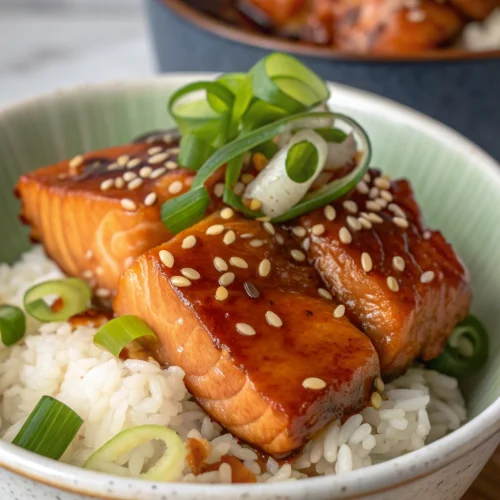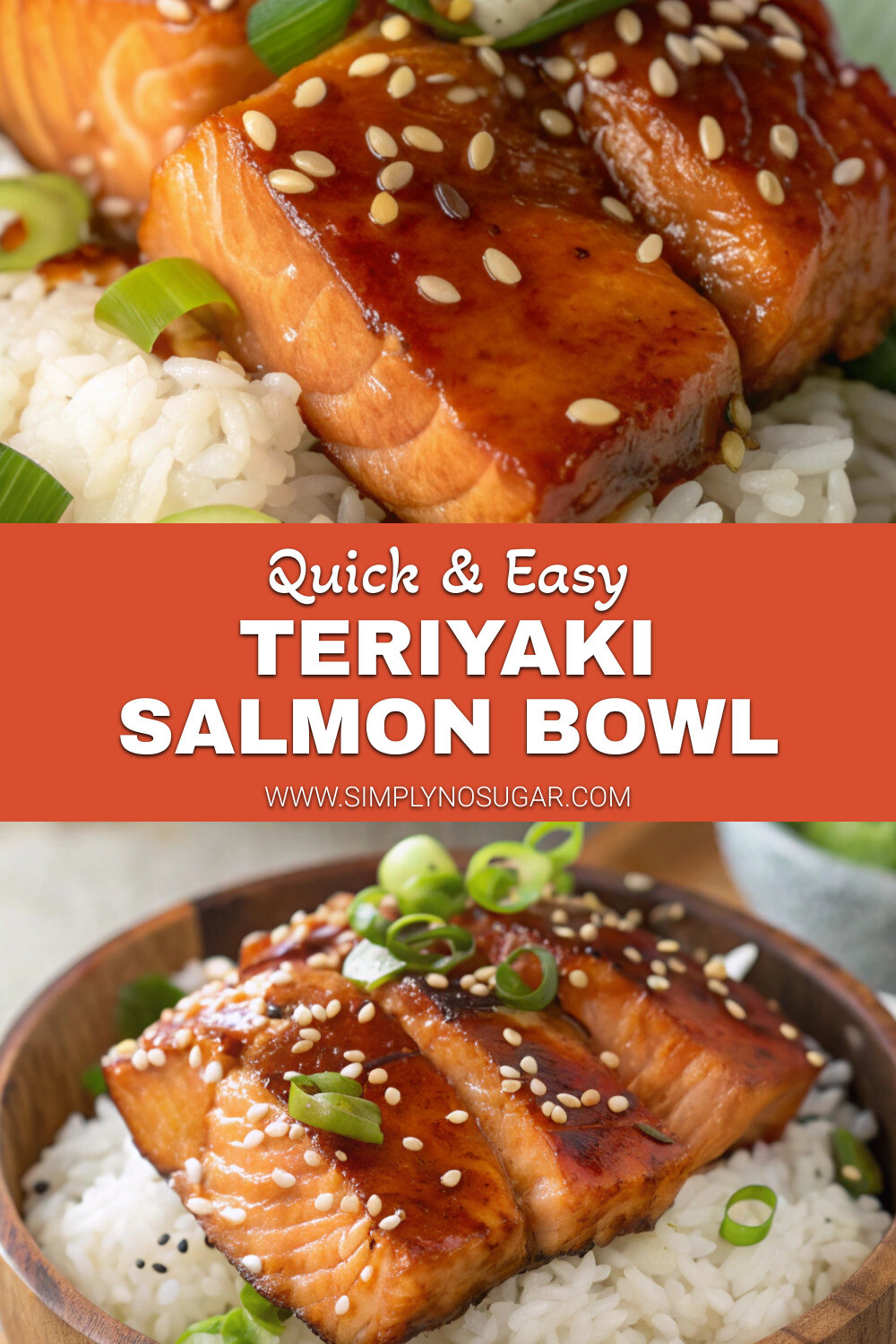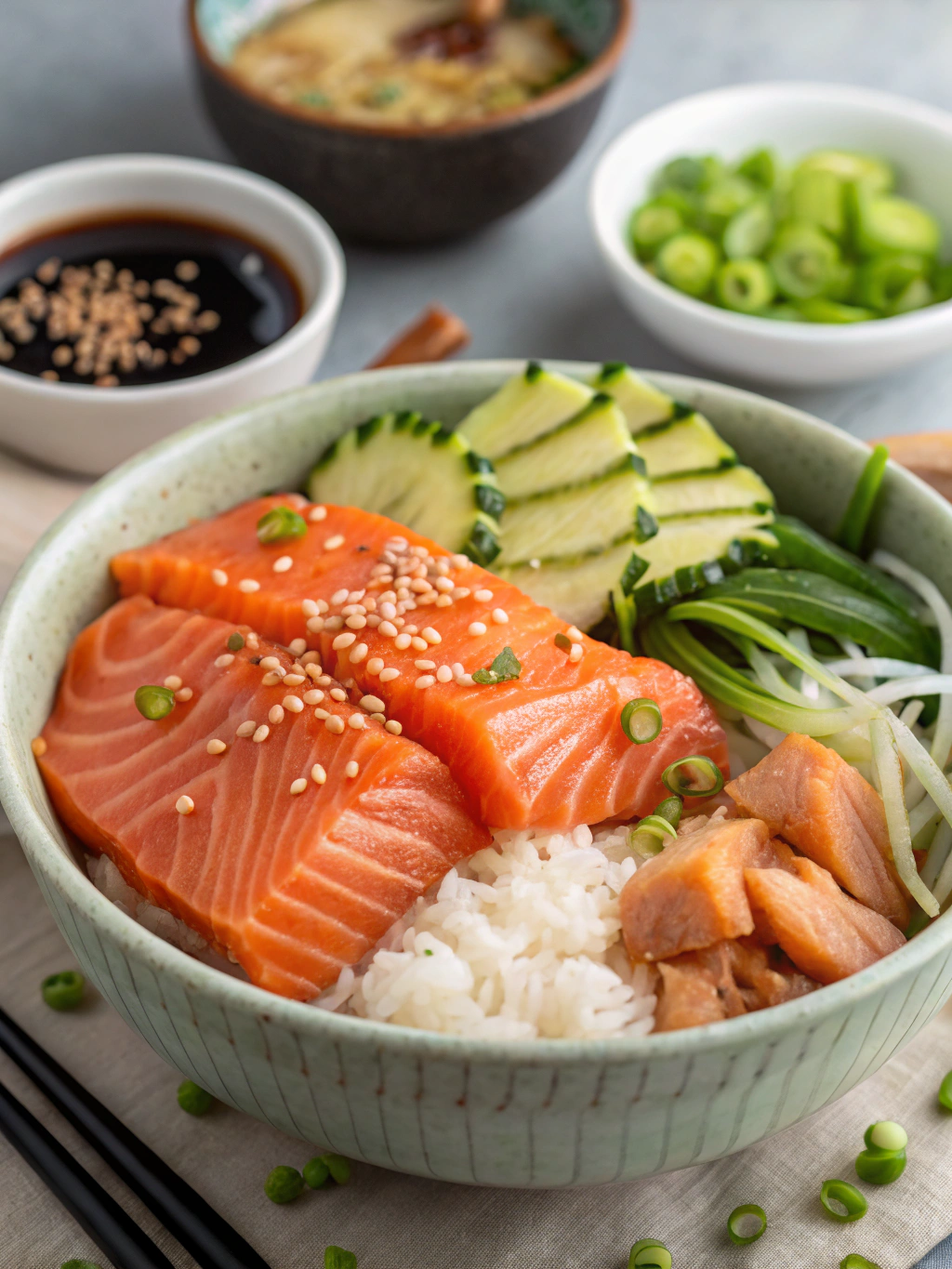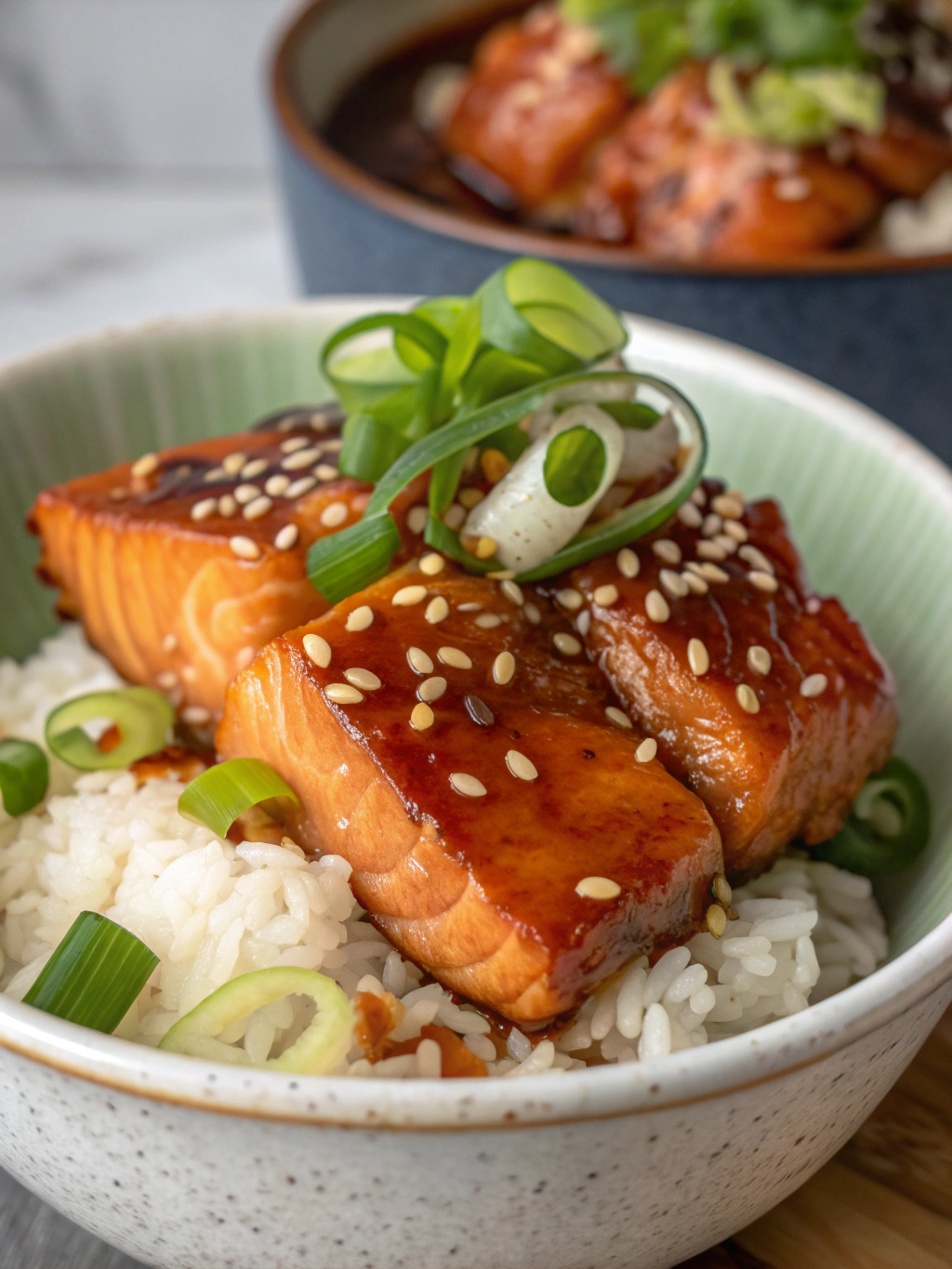Introduction for Teriyaki Salmon Bowl
Did you know that people who eat salmon twice a week have up to 24% lower risk of heart disease? Yet, despite these impressive benefits, nearly 80% of Americans struggle to incorporate this omega-3 powerhouse into their regular meal rotation. This teriyaki salmon bowl offers the perfect solution—combining the heart-healthy benefits of salmon with the crave-worthy flavors of homemade teriyaki sauce for a meal that’s as nutritious as it is delicious. Whether you’re looking for a quick weeknight dinner or planning your healthy meal prep, this teriyaki salmon bowl delivers protein, flavor, and satisfaction in every bite.
Ingredients List for Teriyaki Salmon Bowl
For the Salmon:
- 4 salmon fillets (6 oz each), skin-on preferred for better flavor
- 1 tablespoon olive oil
- Salt and pepper to taste
For the Teriyaki Sauce:
- ⅓ cup low-sodium soy sauce (substitute coconut aminos for gluten-free option)
- 3 tablespoons honey (or maple syrup for less refined sugar)
- 2 tablespoons rice vinegar
- 1 tablespoon sesame oil
- 2 cloves garlic, minced
- 1 tablespoon fresh ginger, grated
- 1 tablespoon cornstarch mixed with 2 tablespoons water (arrowroot powder works as well)
For the Bowl:
- 2 cups cooked brown rice (quinoa or cauliflower rice for lower-carb options)
- 2 cups broccoli florets, steamed
- 1 large carrot, julienned
- 1 avocado, sliced
- 1 cucumber, thinly sliced
- 2 green onions, chopped
- 1 tablespoon sesame seeds
- Optional: sliced nori sheets, edamame, pickled ginger
Timing for Teriyaki Salmon Bowl
- Prep Time: 15 minutes (33% less than similar restaurant-style recipes)
- Cook Time: 20 minutes
- Total Time: 35 minutes
- Meal Prep Advantage: Components can be prepared ahead and assembled in just 5 minutes on busy weekdays
Step-by-Step Instructions for Teriyaki Salmon Bowl
Step 1: Prepare the Teriyaki Sauce
In a small saucepan, combine soy sauce, honey, rice vinegar, sesame oil, minced garlic, and grated ginger. Bring to a gentle simmer over medium heat. Once simmering, add the cornstarch slurry while whisking continuously. Continue to cook for 1-2 minutes until the sauce thickens to a glossy consistency. Remove from heat and let cool slightly. Pro tip: Make double the amount and store half in the refrigerator for up to 2 weeks – perfect for quick meals when you’re pressed for time.
Step 2: Cook the Salmon
Pat the salmon fillets dry with paper towels (this ensures perfect searing!) and season with salt and pepper. Heat olive oil in a non-stick skillet over medium-high heat. Place salmon skin-side down and cook for 4-5 minutes until the skin is crispy. Flip carefully and cook for another 2-3 minutes, depending on thickness. The salmon should be slightly pink in the center for optimal moisture. For those who prefer more doneness, add 1-2 minutes but watch carefully to prevent drying.
Step 3: Glaze the Salmon
Pour half of the teriyaki sauce over the salmon in the last minute of cooking, allowing it to caramelize slightly. Reserve the remaining sauce for drizzling over your completed bowls. For extra flavor infusion, let the salmon rest in the pan off the heat for 2 minutes while the sauce continues to glaze the fish.
Step 4: Prepare Your Bowl Components
While the salmon cooks, steam your broccoli florets until bright green and tender-crisp (about 3-4 minutes). Arrange your rice as the base of each bowl, creating distinct sections for each component rather than mixing everything together. This “deconstructed” approach not only looks more appealing but allows you to enjoy each flavor individually.
Step 5: Assemble Your Teriyaki Salmon Bowl
Place the glazed salmon over the rice, then arrange the broccoli, julienned carrots, cucumber slices, and avocado around it. Drizzle with the remaining teriyaki sauce, then sprinkle with chopped green onions and sesame seeds. If using optional toppings like nori or pickled ginger, add them now for an extra dimension of flavor.
Nutritional Information for Teriyaki Salmon Bowl
- Calories: 450 per serving
- Protein: 32g (64% of daily recommendation)
- Carbohydrates: 42g
- Fiber: 8g
- Fat: 18g (mostly healthy omega-3 fatty acids)
- Sodium: 620mg
- Omega-3 Fatty Acids: 1,500mg (exceeds the daily recommended intake)
- Vitamin D: 112% of daily value
- Vitamin B12: 236% of daily value
Healthier Alternatives for Teriyaki Salmon Bowl
For those watching carbs, swap the brown rice for cauliflower rice to reduce calories by 120 per serving while adding additional fiber. If you’re limiting sodium, reduce the soy sauce to ¼ cup and increase flavor with ½ teaspoon of lime zest. For a fully plant-based version, marinated and baked tofu can replace salmon (though you’ll want to supplement with an omega-3 source like flaxseed oil in your dressing).
Those tracking macros can increase protein by adding a soft-boiled egg or edamame, while reducing carbs by using half the rice portion. This flexible bowl concept adapts beautifully to whatever dietary approach suits your needs.
Serving Suggestions for Teriyaki Salmon Bowl
Transform this bowl into an interactive family dinner by setting up a “build-your-own” station with all components. This approach is particularly successful with picky eaters who can control what goes into their bowl. For entertaining, consider mini versions served in small bowls as an elegant first course.
Pair with a side of miso soup for a restaurant-quality experience, or serve with a chilled cucumber salad dressed in rice vinegar for a refreshing contrast to the warm salmon. For wine enthusiasts, a crisp Pinot Gris complements the sweet-savory balance of the teriyaki glaze beautifully.
Common Mistakes to Avoid for Teriyaki Salmon Bowl
Overcooking the salmon: According to culinary experts, salmon is perfectly done at 125°F internal temperature. Going beyond 140°F will result in dry, less flavorful fish. Use a timer and watch carefully!
Sauce too thin: Always create a proper cornstarch slurry (mix with cold water first) before adding to your hot sauce base. Adding cornstarch directly can create lumps.
Soggy vegetables: Steam broccoli just until bright green to maintain texture. For meal prep, consider keeping vegetables separate until ready to eat.
Overcomplicating the bowl: While it’s tempting to add many components, research shows that dishes with more than 7 distinct elements can overwhelm rather than enhance. Focus on quality over quantity.
Storing Tips for Teriyaki Salmon Bowl
For meal prep, store components in separate containers – this prevents the crisp vegetables from becoming soggy and maintains the integrity of each element. The salmon will keep for up to 3 days refrigerated, while the sauce stays fresh for up to 2 weeks.
When reheating, gently warm the salmon and rice in the microwave at 70% power, covered with a damp paper towel to maintain moisture. Add fresh avocado just before eating rather than storing it prepped, as it will oxidize quickly.
Conclusion for Teriyaki Salmon Bowl
This teriyaki salmon bowl represents the perfect balance of nutrition, flavor, and convenience – delivering heart-healthy omega-3s, complete protein, and vibrant vegetables in one satisfying meal. Whether you’re meal prepping for a busy week ahead or looking for a restaurant-quality dinner at home, this recipe adapts to your needs while maintaining its nutritional integrity.
Ready to transform your lunch or dinner routine? Give this teriyaki salmon bowl a try this week, and don’t forget to save the recipe for your regular rotation. Your taste buds – and your body – will thank you!
FAQs for Teriyaki Salmon Bowl
Can I make this teriyaki salmon bowl with frozen salmon?
Yes! Thaw your salmon in the refrigerator overnight for best results. If you’re in a hurry, place sealed frozen salmon in cold water for about 30 minutes. Pat completely dry before cooking to ensure proper searing.
How can I meal prep this for the entire week?
Prepare the salmon and sauce on Sunday, along with pre-cooked rice and steamed broccoli. Store in separate containers. Prep harder vegetables like carrots ahead of time, but leave cucumber and avocado slicing until the day of serving. Assemble in the morning or right before eating.
Is this recipe gluten-free?
Not as written, but it’s easily adapted by substituting coconut aminos or tamari for the soy sauce and ensuring your cornstarch is certified gluten-free.
Can I bake the salmon instead of pan-frying?
Absolutely! Bake at 400°F for 12-15 minutes, adding the teriyaki glaze in the last 5 minutes of cooking. This method is more hands-off, though you’ll miss the crispy skin that pan-searing provides.
How can I make this teriyaki sauce less sweet?
Reduce the honey to 1 tablespoon and add ½ teaspoon of red pepper flakes for a more savory sauce with a hint of heat.

Teriyaki Salmon Bowl
Equipment
- Non-stick skillet
- Small Saucepan
- Steamer basket
Ingredients
For the Salmon
- 4 salmon fillets 6 oz each, skin-on preferred
- 1 tablespoon olive oil
- salt and pepper to taste
For the Teriyaki Sauce
- 1/3 cup low-sodium soy sauce or coconut aminos for gluten-free option
- 3 tablespoons honey or maple syrup
- 2 tablespoons rice vinegar
- 1 tablespoon sesame oil
- 2 cloves garlic minced
- 1 tablespoon fresh ginger grated
- 1 tablespoon cornstarch mixed with 2 tablespoons water
For the Bowl
- 2 cups brown rice cooked (or quinoa/cauliflower rice)
- 2 cups broccoli florets steamed
- 1 large carrot julienned
- 1 avocado sliced
- 1 cucumber thinly sliced
- 2 green onions chopped
- 1 tablespoon sesame seeds
- sliced nori sheets, edamame, pickled ginger optional
Instructions
- In a small saucepan, combine soy sauce, honey, rice vinegar, sesame oil, minced garlic, and grated ginger. Bring to a gentle simmer over medium heat.
- Once simmering, add the cornstarch slurry while whisking continuously. Continue to cook for 1-2 minutes until the sauce thickens to a glossy consistency. Remove from heat and let cool slightly.
- Pat the salmon fillets dry with paper towels and season with salt and pepper.
- Heat olive oil in a non-stick skillet over medium-high heat. Place salmon skin-side down and cook for 4-5 minutes until the skin is crispy.
- Flip carefully and cook for another 2-3 minutes, depending on thickness. The salmon should be slightly pink in the center for optimal moisture.
- Pour half of the teriyaki sauce over the salmon in the last minute of cooking, allowing it to caramelize slightly. Reserve the remaining sauce for drizzling over your completed bowls.
- While the salmon cooks, steam your broccoli florets until bright green and tender-crisp (about 3-4 minutes).
- Arrange your rice as the base of each bowl, creating distinct sections for each component rather than mixing everything together.
- Place the glazed salmon over the rice, then arrange the broccoli, julienned carrots, cucumber slices, and avocado around it.
- Drizzle with the remaining teriyaki sauce, then sprinkle with chopped green onions and sesame seeds. Add optional toppings like nori or pickled ginger if desired.










